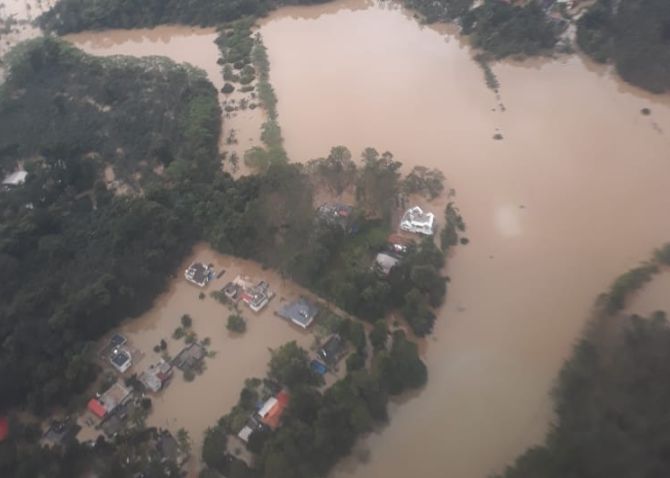Given the intensity of the rain, at least a third of this crisis could have been averted had Tamil Nadu heeded Kerala's requests..
Abhishek Waghmare reports.

The Great Deluge of 99 -- or 99le vellapokkam -- is how Kerala remembers, through oral history, the horrors of the flood of 1924 (1099 in the Malayalam Era), regarded as the worst in the recorded history of the region. Kerala was not a state then.
Unprecedented rain this week in some districts of Kerala have left the state in the worst flood situation of the century.
The flow of water in some stretches of the Periyar was 1,800 cubic metres -- or about one swimming pool of water -- per second, almost equal to that recorded in 1924 as recorded by the colonialists, state officials said.
The impossibility of predicting the intensity of a deluge beforehand, the rise in extreme rainfall events since the second half of 20th century, and the dearth of inter-state cooperation when it comes to water disputes have manifested into yet another disaster, reminiscent of the Uttarakhand cloud burst and havoc of 2013 and Chennai floods of 2016.
'Kerala is facing its worst flood in 100 years. 80 dams opened, 324 lives lost and 223,139 people are in about 1500+ relief camps,' Chief Minister Pinarayi Vijayan tweeted later in the day.
However, given the intensity of the rain, at least a third of this crisis could have been averted had Tamil Nadu heeded Kerala's requests.
The Mullaperiyar dam, situated in Kerala but in Tamil Nadu's possession, has the permission to maintain full reservoir level at 142 feet of the dam wall, as mandated by the Supreme Court. But Kerala, in its submission to the Supreme Court had asked to make 139 feet the upper limit.
Had the TN government started releasing water from the dam into Kerala when it had reached the critical level of 139 feet, the full blown crisis could have been averted to some extent, officials said.
"The three feet make a lot of difference. They contain 792 million cubic feet of water, which when released translates into a flow of about 9,000 cubic feet per seconds (cusecs), which got added to the flow caused by the rain," a senior official from Kerala's water resources department said.
The Mullaperiyar dam releases its water slowly into the Vaigai, and most of it, and at a faster rate, into the Idukki dam, where rainfall was the heaviest.
This flooded the already full-to-brim Idukki dam, which releases water into the Periyar basin, where most of the casualties have occurred.
A flow of 36,000 cusecs was recorded in parts of the Periyar on August 15, almost the highest ever.
"The flow on August 16 was definitely more than that, but we await official figures," said an official.
Keeping the 3-feet buffer for the purpose of flexibility in times of flood in the Mullaperiyar could have improved the flood manoeuvring ability of the water, and averted the crisis, at least to some extent.
The apex court, hearing a petition from a Kerala resident, ordered the release of the water on Friday. But this would have worked only as a preventive and not a curative measure, officials said.
The northern district of Idukki in Kerala recorded a massive 68 cm rainfall in a week to August 15, which is equivalent to two-thirds of the annual national average rainfall in India.
The state, as a whole, received 30 per cent more rainfall than normal in that week, and the downpour did not stop until the night of August 16.
The normal mark of seasonal rainfall of June-September had already been crossed as early as till August 16, in 11 of the 13 districts in the state.
Idukki has received almost twice the rainfall it received till date.
Scientists from the Indian Institute of Tropical Meteorology, Pune, have, since the 2005 deluge of Mumbai, shown from their research that there is an 'alarming' rise in both the number and the intensity of extreme rainfall events in India, as a result of climate change.
'The inter-annual variation of extreme rainfall in a single day shows highly significant rising trend during 1951-2007. The unprecedented rainfall on 26-27 July 2005 over the Mumbai Metropolitan city appears to be a realisation of this long-term trend,' Ashwini Ranade and Nityanand Singh of the IITM noted in a 2010 study.
'Many places in India show an increasing tendency in the frequency of extreme hourly rainfall events, except for a few stations in north east India and the southern peninsula,' N R Deshpande and others noted in a 2011 study published in the International Journal of Climatology.
Water in dams built in rivers flowing west in Kerala (entering the Arabian Sea) is 50 per cent more than the average of 10 years today, according to data from the Central Water Commission.











